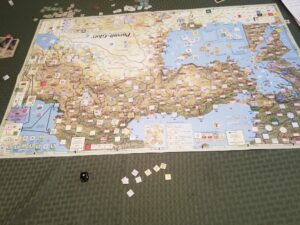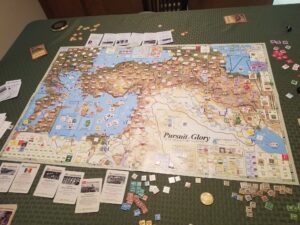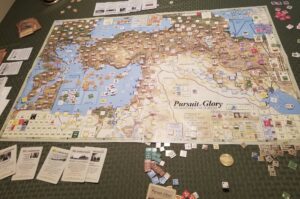Quick Comment: This game was played using the First Edition, not the recently published Second Edition which, from what I gather, contains some significant rules modifications.
And now….Wargame Forensics. Why? I forgot to include the cards played in my map photo. So, here’s a stab at what happened during the Summer 1915.
The major development was the Allied invasion at Gallipoli and accompanying Central Powers response. It was business as usual in Caucasia – with more attrition – and a lack of activity on other fronts. At this point, the Ottoman replacement pool is dangerously shallow.
During the Fall 1915 turn, the Allies shifted focus to Mesopotamia, eyeing an undefended Baghdad. The Marsh Arabs tribe frustrated the Allied advance, buying time for the Central Powers to deploy forces to the threatened city.
The Romania Enters The War card was played in error. Tim noticed that the pre-conditions had not been met (Allies in Salonika), so the forces involved were taken off the table and Tim used the card for operations.
The Central Powers were in reaction mode, trying to cobble defenses together in Mesopotamia and Caucasia, attempting to build up the replacement pool, as well as maintaining some momentum in their effort to “Set The East Ablaze” using dissident tribes.
Our final turn was Winter 1916.
The Allies played the Russian Winter Offensive card, reducing the negative effects on winter attacks, and so maintaining the momentum of their push towards Anatolia. The Asquith-Lloyd George card allowed an increase in British aid to Russia in the form of replacement points. These positive developments would help Russia delay the beginning of the revolution.
The Central powers gained Bulgaria as an ally (forces cannot be set up until the end of the turn), and the Ottomans were able to stabilize both the Mesopotamian and Caucasian fronts. For how long is anybody’s guess.
As usual, just when things were getting good, or dicey depending on one’s perspective, it was time to pack it up.
One overarching observation is how both of us shied away from any significant effort(s) outside of the Caucasian front. Yes, Tim did invade both Mesopotamia and Gallipoli, but with limited assets. Neither of us showed any interest in the Sinai or Egypt. The historical Allied invasion at Salonika did not occur in this game.
My other impressions from the Central Powers’ perspective are:
- Is it worth pursuing a peripheral strategy focusing on Jihad and tribal actions?
- How quickly Ottoman forces are reduced.
- Given this attrition, is there a more defensible series of positions in Caucasia that will not provide the Russian player with the ability to further delay the revolution?
- Outside of Bulgaria (and perhaps the peripheral strategy) what are the opportunities for the Central Powers to be pro-active?
My head is starting to throb. Time to play something less taxing.


